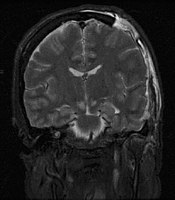
Photo from wikipedia
We sought to determine whether gravity-induced changes in intracranial pressure influence cerebral blood flow regulation. Accordingly, nine young healthy men were studied while supine (0 degree) and during mild changes… Click to show full abstract
We sought to determine whether gravity-induced changes in intracranial pressure influence cerebral blood flow regulation. Accordingly, nine young healthy men were studied while supine (0 degree) and during mild changes in hydrostatic pressure induced by head-up tilt at +20 and +10 degrees (HUT+20 and HUT+10) and head-down tilt at -20 and -10 degrees (HDT-20, HDT-10). Blood flows were measured in the internal and external carotid, and vertebral arteries (ICA, ECA and VA). Intraocular pressure (IOP) was measured as indicator of hydrostatic changes in intracranial pressure. A posture change from HUT+20 to HDT-20 increased IOP by +5.1 ± 1.9 mmHg (P < 0.001) and ECA blood flow (from 61.7±26.1 to 87.6 ± 46.4 ml/min, P = 0.004), but did not affect ICA (P = 0.528) or VA (P = 0.101) blood flow. The increase in ECA flow correlated with the tilt-angle and resultant changes in intracranial pressures (by IOP) thus indicating a passive-hydrostatic gravitational dependency (r = 0.371, P = 0.012). Contrary, ICA flow remained constant and thus well protected against moderate orthostatic stress. When ICA flow was corrected for the gravitational changes in intracranial pressures (by IOP), it demonstrated the same magnitude of gravitational dependency as ECA. These findings suggest that passive-hydrostatic increases in intracranial pressure outbalance the concurrent increase in arterial feeding pressure to the brain and thus prevent cerebral hyper-perfusion during HDT. The mechanism for maintaining constant cerebral flow was by increased ECA flow thus supporting the role of these vascular beds as a shunting pathway.
Journal Title: Journal of applied physiology
Year Published: 2020
Link to full text (if available)
Share on Social Media: Sign Up to like & get
recommendations!